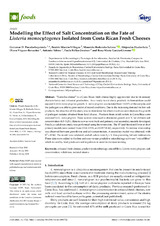Modelling the Effect of Salt Concentration on the Fate of Listeria monocytogenes Isolated from Costa Rican Fresh Cheeses
Autor
Posada Izquierdo, Guiomar Denisse
Mazón-Villegas, Beatriz
Redondo-Solano, Mauricio
Huete-Soto, Alejandra
Víquez-Barrantes, Diana
Valero Díaz, Antonio
Fallas-Jiménez, Paula
García Gimeno, Rosa María
Editor
MDPIFecha
2021Materia
Artisanal fresh cheesePredictive microbiology
microHibro
Listeria monocytogenes
Salt concentration
Validation
Isolated strains
METS:
Mostrar el registro METSPREMIS:
Mostrar el registro PREMISMetadatos
Mostrar el registro completo del ítemResumen
“Turrialba cheese” is a Costa Rican fresh cheese highly appreciated due to its sensory characteristics and artisanal production. As a ready-to-eat dairy product, its formulation could support Listeria monocytogenes growth. L. monocytogenes was isolated from 14.06% of the samples and the pathogen was able to grow under all tested conditions. Due to the increasing demand for low-salt products, the objective of this study was to determine the effect of salt concentration on the growth of pathogen isolates obtained from local cheese. Products from retail outlets in Costa Rica were analyzed for L. monocytogenes. These isolates were used to determine growth at 4 °C for different salt concentration (0.5–5.2%). Kinetic curves were built and primary and secondary models developed. Finally, a validation study was performed using literature data. The R2 and Standard Error of fit of primary models were ranked from 0.964–0.993, and 0.197–0.443, respectively. An inverse relationship was observed between growth rate and salt concentration. A secondary model was obtained, with R2 = 0.962. The model was validated, and all values were Bf > 1, thus providing fail-safe estimations. These data were added to the free and easy-to-use predictive microbiology software “microHibro” which is used by food producers and regulators to assist in decision-making.

